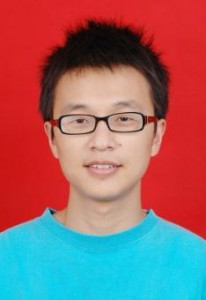
TITLE: Graduate Student (PhD)
PROGRAM: Bioinformatics (2015-present)
EMAIL: ningw2015@nullucla.edu
OFFICE: Boyer 510B
EDUCATION:
BS Electrical Engineering, University of Science and Technology of China, 2013
Research Interests
Ning is passionate about developing quantitative platform to understand and predict gene response under multiple transcription factors control in macrophage pathogen response. Ning addresses this challenge by integrating mechanistic and statistical model to abstract biological insight from high-throughput sequencing data.

TITLE: Postdoctoral Scholar
OFFICE: Boyer 570
EMAIL: koushikroy@nullucla.edu
PHONE: 310-210-4357
EDUCATION:
Ph.D. Biotechnology, CSIR-Indian Institute of Chemical Biology (2014, CU)
M.Sc. Chemistry, Jadavpur University (2006)
Research Interests
NFκB is a key regulator of B cell activation with subsequent proliferation and differentiation. cRel is necessary for B cell proliferation and RelA is necessary for B cell differentiation. Misregulated NFκB is associated with immunological disease such as B cell lymphoma.We have developed an integrated system of single cell microscopy tracking and dye dilution analysis tool to quantitatively study B cell population dynamics in terms of cell biological parameters at the single cell level. I am interested to study what is the role of dimer and the dynamic to the B cell fate decision at single cell level and population level.
Awards
Boyer/Parvin Postdoctoral Award, Recognizing Excellence in Postdoctoral Research, UCLA, 2019
Best Presentation, Preventive Medicine: Current Perspective, India, 2014
Best Presentation, CSIR-Indian Institute of Chemical Biology on Immunology day, India, 2014
Best Poster, International Symposium on Molecular Signaling, India, 2013
Best Poster, Society of Biological Chemist Symposium, India, 2012
Publications
16. Roy K*, Mitchell S*,Liu Y, Ohta S, Lin YS, Metzig MO, Nutt SL, Hoffmann A. A Regulatory Circuit Controlling the Dynamics of NFκB cRel Transitions B Cells from Proliferation to Plasma Cell Differentiation. Immunity. 2019 Mar 19;50(3):616-628. (*Equal contribution)
15. Mitchell S*, Roy K*, Zangle TA, Hoffmann A. Non-genetic origins of cell-to-cell variability in B-lymphocyte proliferation. Proceedings of the National Academy of Sciences, USA (2018), Mar 7. pii: 201715639. doi: 10.1073/pnas.1715639115. (*Equal contribution)
14. Roy K, Shokhirev M, Mitchell S, Hoffmann A. Deriving quantitative cell biological information from dye-dilution lymphocyte proliferation experiments. Methods in Molecular Biology (2018), 2018;1707:81-94
13. Roy K, Mazumder A, Ghosh P, Naiya G, Ghosh B, Roy S. A Peptide-based Synthetic Transcription Factor Selectively Activates Transcription in a Mammalian Cell. Chemical Communications, 2018, 54(13):1611-1614
12. Roy K*, Mandloi S*, Chakrabarti S, Roy S. Cholesterol Corrects Altered Conformation of MHC-II Protein in Leishmania donovani Infected Macrophages: Implication in Therapy. PLOS Neglected Tropical Diseases, 2016 May 23;10(5):e0004710. (*Equal contribution)
11. Ghosh M*, Roy K*, Das Mukherjee D, Chakrabarti G, Roy Choudhury K, Roy S. Leishmania donovani infection enhances lateral mobility of macrophage membrane protein which is reversed by liposomal cholesterol. PLOS Neglected Tropical Diseases, 2014 Dec4;8(12):e3367. (*Equal contribution)
10. Dhar A, Mallick S, Ghosh P, Maiti A, Ahmed I, Bhattacharya S, Mandal T, Manna A, Roy K, Singh S, Nayak DK, Wilder PT, Markowitz J, Weber D, Ghosh MK, Chattopadhyay S, Guha R, Konar A, Bandyopadhyay S, Roy S. Simultaneous Inhibition of Key Growth Pathways in Melanoma Cells and Tumor Regression by a Designed Bidentate Constrained Helical Peptide. Biopolymers-Peptide Science, 2014 Apr; 101(4):344-58.
9. Roy K, Naskar K, Ghosh M, Roy S. Class II MHC/peptide interaction in Leishmania donovani infection: implications in vaccine design. Journal of Immunology, 2014, 192(12):5873-80.
8. Roy K, Ghosh M, Pal TK, Chakrabarti S, Roy S. Cholesterol lowering drug may influence cellular immune response by altering MHC II function. Journal of Lipid Research, 2013, 54(11):3106-15.
(F1000 Faculty: recommended)
7. Ghosh M, Roy K, Roy S. Immunomodulatory effects of antileishmanial drugs. Journal of Antimicrobial Chemotherapy, 2013, 68(12):2834-8.
6. Ghosh M, Solanki AK, Roy K, Dhoke RR, Ashish, Roy S. Carrier protein influences immunodominance hierarchy: implication in vaccine design. Vaccine, 2013, 31(41):4682-8.
5. Mondal S, Bardhan R, Mondal B, Dey A, Mukhopadhyay SS, Roy S, Guha R, Roy K. Synthesis, characterization and in vitro cytotoxicity assessment of hydroxyapatite from different bioresources for tissue engineering application. Bulletin of Material Science, 2012, 35(4), 683-691.
4. Roy S, Ghosh P, Roy NS, Mazumder A, Roy K, Manna AK, Mallick S, Ahmed I. Peptide based Molecules as Protein-Protein Interaction Inhibitors: Tools for Chemical Genetics and Therapy. Current Chemical Biology, 2012, 6(2):145-163. (Review)
3. Mazumder A, Maiti A, Roy K, Roy S. A synthetic peptide mimic of λ-Cro shows sequence-specific binding in vitro and in vivo. ACS Chemical Biology, 2012, 15;7(6):1084-94.
2. Sen S, Roy K, Mukherjee S, Mukhopadhyay R, Roy S. Restoration of IFNγR subunit assembly, IFNγ signaling and parasite clearance in Leishmania donovani infected macrophages: role of membrane cholesterol. PLoS Pathogen, 2011, September 7(9), e1002229.
1. Raha P, Chattopadhyay S, Mukherjee S, Chattopadhyay R, Roy K, Roy S. Alternative sigma factors in the free state are equilibrium mixtures of open and compact conformations. Biochemistry, 2010, 49, 9809–9819.





